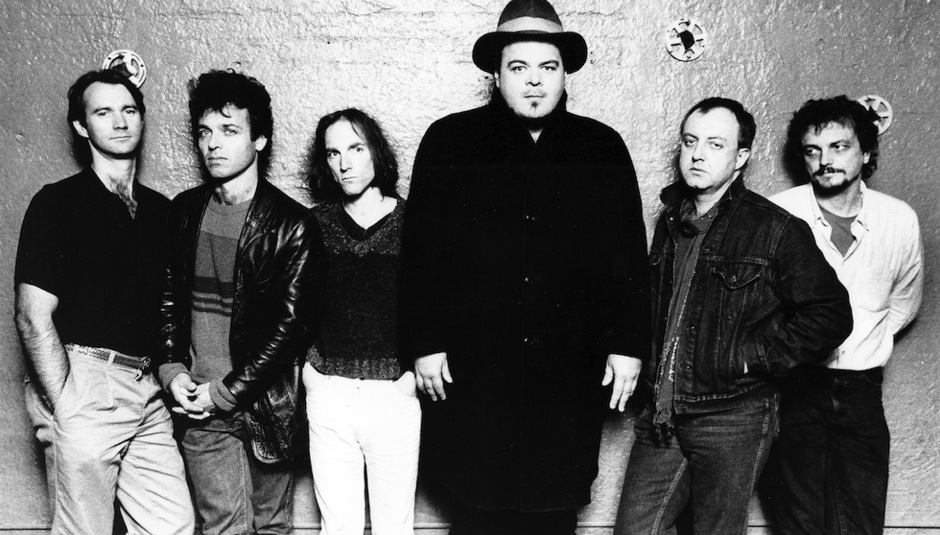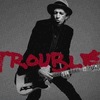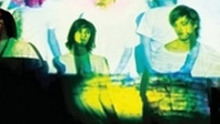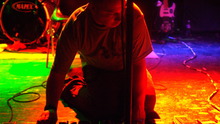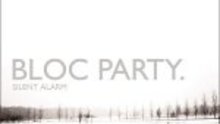For years I wanted the complete Pere Ubu back catalogue. I’d tease myself as a teenager walking into record shops and pick up one of the million albums that made up their back catalogue, or so it seemed to me at the time, look at it longingly, then walk around the shop with it under my arm on display like some indie badge of honour. I’d catch people checking it out and do that weak smile and nod all British children are taught at school. Then, like clockwork, I’d come across something more contemporary, then have an internal monologue discussing the pros and cons of each album and predictably put Ubu back and buy an album of such banality I now can’t even remember what it was. Writing this now I’m slightly embarrassed of my younger self, but we’ve all been there right…?
Eventually I eventually started to make inroads in to their murky Avant-Garage world. I’d find a copy of Dub Housing cheap at record fair, I’d hear a track from The Art of Walking at a house party then order it from the local record shop and the next day, a friend sold off their collection to pay for a holiday and I’d picked up Cloudland and New Picnic. Then one day the mother-load, in my local junk shop they had most of the remaining albums I was missing. Until one day I realised I had the complete (studio) back catalogue. A few years after this momentous occasion online shopping and streaming services became a thing and my years of hunting had been wiped out almost overnight. While it was nice to look at the fruits of my labours, I did feel a bit cheated that now after a few clicks I would be able to access what have taken several years to complete. So I did the sensible thing that anyone else in my position would have done, I started on another band with an even bigger back catalogue. Fuck the internet! Collecting is still an art form!
So if you are like a teenage me and not sure where to start, what to avoid and what to cherish, I thought I’d go through Pere Ubu’s weighty back catalogue in one sitting, pretty much, because I love a challenge and I haven’t heard some of these for a while.
1) The Modern Dance (1978)
Released in early 1978 The Modern Dance showed that there was life after punk. Opening with piercing feedback, ‘Non-Alignment Pact’ lets you know that The Modern Dance isn’t going to be an easy listen, but you knew that already right? Through a wall of feedback a chugging guitar breaks through and David Thomas’ rambling cacophonous vocals come in, and Avant-Garage was born. Taking elements from punk, garage, art rock, post-punk and injecting them with dark, but amusing lyrics Pere Ubu managed to create an album full of catchy riffs, discordant production techniques and a driving rhythm section that showed 1978 its reflection. Though slightly distorted by a carnival mirror. Ironically this might not be the best starting place for Ubu, however it’s an essential to have.
2) Dub Housing (1978)
Not only the second Pere Ubu album, but their second album in 1978. Dub Housing follows the Avant-Garage blueprint of The Modern Dance, but everything is turned up, or should that be down a notch. The music is denser in composition, and while none of it could be classed as dub, the bass is more prominent and there is more space in the mix, giving Thomas room to moan and wail his themes of alienation and disaffection. The lyrics also start to show Thomas’ gift at black comedy, when he howls “I have desires” in opening track Navvy, it’s almost like a punch line to a surreal joke. Even when Ubu break into “What Became of the Drunken Sailor” in the closing stages of ‘Caligari's Mirror’ you go along with it as it all makes sense, in a perverse way. To some Dub Housing is as good as Ubu ever got, and next to The Modern Dance its Thomas and co at their purest, pushing boundaries in composition and what a singer could be. This is another essential Ubu release!
3) New Picnic Time (1979)
Opening with a jocular “It’s me again!” while an angular guitar plays an incessant riff over grieving ghostly moans, ad hoc percussion and plinky-plonky piano. New Picnic Time is Ubu during their Captain Beefheart phase. Odd time signatures and dissonant tones pepper the songs and Thomas’ stream of consciousness barks equal Don Van Vliet at his most free. It also marks the end of Pere Ubu’s first ‘classic’ line up. Original guitarist Tom Herman would leave after gruelling tours and a fractured recording process. See the Beefheart comparisons weren’t just in the sound. Ironically the music doesn’t really lead you to believe that the band was in turmoil. Yes it’s all over the shop, but it’s not the downer it could have been, at times next to The Modern Dance and Dub Housing it’s slightly upbeat. While New Picnic Time isn’t as stark or ground breaking as The Modern Dance and Dub Housing it does show a band trying to find their feet and not just challenge audiences, but themselves.
4) The Art of Walking (1980)
If New Picnic Time was Pere Ubu going through a Beefheart phase, The Art of Walking is them trying to emulate The Residents. ‘Young Miles in the Basement’ sounds like Thomas and co deconstructing a song to its most basic elements and then playing them all at the wrong speed and at different times. This is partly down to Mayo Thompson. After Tom Herman’s departure, Thompson stepped in on guitar. Thompson brought an almost free jazz sound to the band, which is great, but Herman’s driving rock riffs underpinned the previous three albums and so were missing. This is Ubu as free as they get. The Art of Waking’s song writing is more about abstract feelings, than ideas and themes. ‘Arabia’ sounds like the Master Musicians of Jajouka after they were hanging out with Brian Jones for too long and had a bad trip in a souk. This new direction is an interesting experiment, but an experiment none the less. Some fans like the freeness of it, while others bemoan the lack of tangible songs. It’s worth a listen, but maybe not until you’ve announced yourself as an Ubu convert.
5) Song of the Bailing Man (1982)
The lessons in abstraction on The Art of Waking where still evident on Song of the Bailing Man, but they were being used for the benefit of the songs, rather than for experiments sake. Through Thompson’s playing is still more detached than Harman’s, the rest of the band works hard to create a tight backing track for his riffs and ideas. While this isn’t Ubu at their best, and it is more enjoyable than The Art of Waking, it does sound forced. On previous albums you get the feeling that everyone in Ubu is a bit weird and everything is done for a reason. On Song of the Bailing Man they sound like they’re going out of their way to out weird. Which is a shame as at this this album contains elements of them at their best, but at others their most pedestrian. Unsurprisingly after its release the band broke up.
6) The Tenement Year (1988)
While David Thomas was recording is 1987 solo album Blame the Messenger, it was noted how it sounded like Pere Ubu. Ubu songs were included in the live set, so the when a year later in 1988 Pere Ubu re-formed and released The Tenement Year, it wasn’t a complete shock. What was a shock however was how poppy this new sound was. ‘Something’s Gotta Give’ opened in similar fashion to ‘Non-Alignment Pact’ with a fall of feedback, glitches and blips. Musically it was akin to The Art of Waking and Song of the Bailing Man, there was a catchiness to it. The intervening six years had helped soften the artiness in their sound, instead of pissing about with loops and odd time signatures, their sonic experiments are for the benefit of the songs. ‘George Had a Hat’ has one of the catchiest guitar riffs Ubu ever committed to tape after Harman’s departure. Lyrically it’s about a guy (or girl) called George and they had a hat that wasn’t all that. ‘Talk to Me’ lyrically is a re-telling of ‘Tell Me More’ from the Grease soundtrack, but for the post-punk generation. One of the standout tracks is ‘Busman’s Honeymoon’. This slow burning ballad contains an accordion, but instead of being out of place, its faux-Tirol/Zydeco sound really helps build emotion. ‘Say Goodbye’ in anyone else repertoire would be a standard ‘rock’ track, but in Ubu’s hands it becomes something vibrant and slightly abstract. ‘We Have Technology’ is another standout track. Thomas discusses how he wishes he could freeze moments and see them from different angles. Did he predict selfies reign of terror in 2015’s society? This is an essential Ubu album. There is something here for original fans, as well as new combers. Buy this. Buy this now!
7) Cloudland (1989)
After The Tenement Year’s unexpected pop leanings, 1989’s Cloudland was a full blown pop treat. Pet Shop Boys, OMD and New Order producer Stephen Hague was at the helm and helped steer Ubu to uncharted waters. Not only did everything sound amazing, tight and crisp, Cloudland was rammed with melody and harmonies that rivalled stars of the day like Simple Minds, Transvision Vamp and Tears for Fears. What’s more they even managed to get a video on MTV. ‘Waiting for Mary’ was a modest success and reached #6 on the US Modern Rock chart. ‘Love Love Love’ reached #88 in the UK chart. Despite this slightly new direction, Thomas’ vocals are filled with his trade mark yelps, barks and caterwauls. This is another must have Ubu album. There are multiple high water marks here, and sound like the best band in the world. In short it’s the album no one dared asked them to make, but we’re glad they did.
8) Worlds in Collision (1991)
Eight albums in and Pere Ubu were showing no signs of fatigue or running out of ideas. After the pop sheen of Cloudland, Worlds in Collision sees Gil Norton at the helm. The Pixies comparisons are fair, but Norton doesn’t just make Worlds in Collision sound like Doolittle II though. Yes opening track ‘Oh Catherine’ does have the Pixies guitar sound and for the first time Thomas is actually ‘singing’, but there is more going on under the surface than on Doolittle. Eric Drew Feldman replaced Allen Ravenstine on keyboards/synth, and it shows as they complement the songs, rather than being a raging beast stalking the songs in the background. ‘Mirror Man’, ‘Worlds in Collision’ and ‘Don’t Look Back' showed they still had a touch of their old ways about them, even if Norton had smoothed the edges even more than Stephen Hague had. Another album that should be in your Ubu collection!
9) Story of My Life (1993)
As soon as Story of My Life starts you know that their experiment in pop is over. ‘Wasted’ is a sea shanty that, on Thomas’ command to “Rock” deviates into an ungainly beast. While the previous albums were gorgeous slab of indie pop, it’s nice to have Ubu back doing what they do best. Making an ungainly noise filled with slightly surreal lyrics. ‘Louisiana Train Wreck’ does show that time with Norton wasn’t wasted. You’d be forgiven for thinking he was still at the desk due to its sound and sheen. Story of My Life is a tight and concise forty minutes. For the first time they found themselves a quartet as Eric Drew Feldman left slightly before recording. This change in line up meant it was all hands on deck, which might explain the svelte sound. Large portions sound like Angelo Badalamenti’s score for Twin Peaks with twangy guitars and mood synths. Saying that, the stand out moment is ‘Postcard’ in which Thomas lists postcards he’s sent/seen, while the band throb, growl and roar in the back ground. Story of My Life isn’t perfect, but its blemishes hint at Ubu’s past and future.
10) Ray Gun Suitcase (1995)
After releasing four commercially minded albums, and not having much to show for it, Pere Ubu decided to revert to their earlier Avant-Garage sound. The new fans must have been slightly bewildered while the older fans rejoiced. Ray Gun Suitcase is claustrophobic, paranoid and rambling. For the first time in their career cracks were beginning to show, and the possible pent up anger of not being bigger after toning their sound down and conforming for the mainstream might explain tracks like ‘Electricity’, ‘Turquoise Fins’, ‘Vacuum in My Head’ and title track ‘Ray Gun Suitcase’. The album boasts possibly one of Ubu’s finest covers in the Beach Boys ‘Surfer Girl’. Its acoustic stripped back nature really helps break up and oppressive nature of the album.
11) Pennsylvania (1998)
Because Pere Ubu have a knack of recording albums in quick succession, themes and ideas can be spread across multiple releases. The claustrophobic, paranoid ramblings of Ray Gun Suitcase are still evident on Pennsylvania, but thanks to the return of Tom Harman, his first album in twenty years, they don’t sound as terrifying as they could have. At the time Thomas was asked about the concept of Pennsylvania “Consider that all the words are owned by the liars and culture is a weapon that's used against us. Where will the ordinary man turn when the media priests sneer?” Where indeed? We can only surmise its Pennsylvania.
12) St. Arkansas (2002)
St. Arkansas is takes the brooding menace of Ray Gun Suitcase and Pennsylvania, but somehow manages to inject infectious melodies and, dare I say, a pop sensibility to create one of the most immediate and rewarding albums in their canon. Thomas’ voice floats around like a tumbleweed while the band create awkward shapes and maelstroms around him. The stand out track is the album closer ‘Dark’. “Oh, my friends don't understand me, And my wife begins to fear, That I've lost some sense of balance, And I've lost the will to live. And the radio, Am radio, Oh, the radio will set you free” Thomas opens the song with while bass and cymbals throb and crash around him. Some of these themes would appear on their next album.
13) Why I Hate Women (2006)
Whatever was going on in David Thomas’ personal life wasn’t good, as Why I Hate Women is all over the shop. ‘Two Girls (One Bar)’ opens well and it sounds like business as usual, but as the album progresses you realise that there isn’t a lot going on. The band appear to be going through the motions. The songs don’t go anywhere, but drift along in a listless malaise. Sadly it’s all a lot of surface noise and not much depth. Even the companion album Why I Remix Women doesn’t help to add any cohesion to the project. This is one to avoid, unless you’re going for the full set.
14) Long Live Père Ubu! (2009)
This is possibly the weirdest album in the entire Pere Ubu back catalogue. It’s an adaption of Alfred Jarry’s 1896 absurdist play Ubu Roi, where their name came from originally, which is a political satire loosely based on William Shakespeare’s Macbeth. Ubu Roi plans to murder the King of Poland, take the crown and become an oppressive dictator. Originally titled Bring Me the Head of Ubu Roi performed and recorded at the Queen Elizabeth Hall in 2008, it was eventually condensed and recorded in a studio with Sarah Jane Morris. Opening track ‘Ubu Overture’ tells you everything you need to know about the piece. Drenched in industrial repercussive reverb, belching vocals repeating “Ubu”, it’s the most terrifying thing they’ve ever committed to tape. Long Live Père Ubu! isn’t a fun listen, but once you get into it, it’s widely enjoyable and hilarious in places! As Thomas said at the time of release "If you're not going to listen to this with the same effort you'd devote to a literary novel, you're wasting your time". He’s correct the more effort you put in the more you get out. It’s the kind of album Vivian Stanshall could have made if he’d got involved in Post-Rock and kicked the bottle instead of the bucket. It’s advisable not to pick this as the first Ubu album you listen to. Maybe pick something from the late 1980’s or early 1990’s.
15) Lady from Shanghai (2013)
After a couple of under whelming releases Pere Ubu had something to prove. On the Lady from Shanghai, they went back to basics and released an album that not only showed that were still capable of releasing exciting changeling music, but that it could be enjoyable too. This is the first album since 1993’s Story of My Life that was a solid Avant-Garage affair. The recording process wasn’t plain sailing though. All the individual musicians were recorded in isolation from each other, taking inspiration from Thomas’ ques. A music version of Chinese Whispers if you will. The results are flawless and for the first time in over a decade Ubu delivered not only on concept, but on content too.
16) Carnival of Souls (2014)
After the success of Lady from Shanghai Thomas and co didn’t wait long for a follow up. Originally conceived as a live score to Herk Harvey 1962 cult horror, to break up touring, the songs took on a life of their own and the resulting album is another high water mark. ‘Visions of the Moon’ is a stand out track on any Ubu release with its lurid clarinet, skewed military drumming and dreamlike synths. As with all the best Ubu songs surrealism isn’t far away “I Live on the Moon. I live in a box on the Moon. My Friends watch me far from below. We Dream. We Dream. Miles away”. ‘Brother Ray’ is another ingot of classic Ubu. Billed as the prequel to Nathanael West’s Day of the Locusts, Thomas’ lyrics sojourn though twelve minutes slow burning mesmerising atmospherics that show Ubu have lost none of their art chops in just under forty years.
So there you have it. Sixteen albums, spread over thirty seven years, in just under thirteen hours. There moments of undoubted genius and glory in these albums, but there are also plenty of musical car crashes, half formed ideas and just plain awfulness. I think I need to sit in a quiet, well lit room for a while…
Pere Ubu play Wickerman Festival this weekend.

